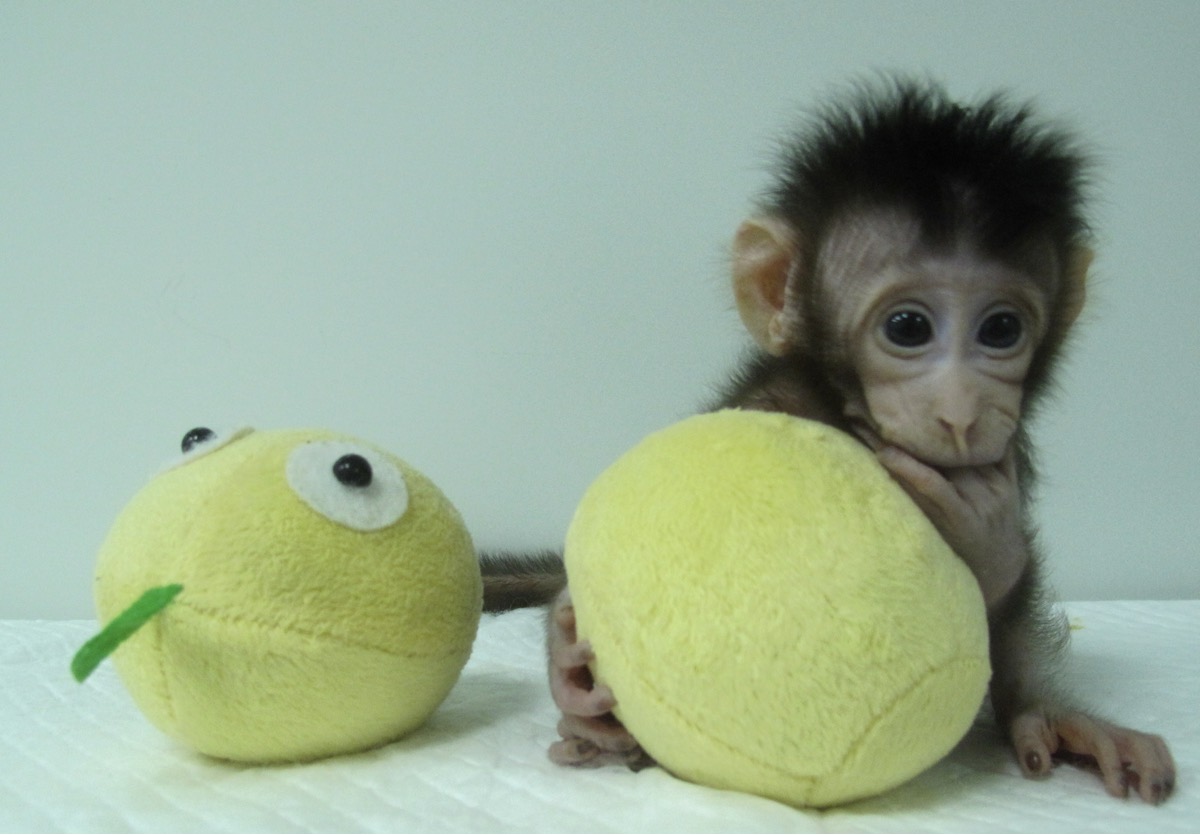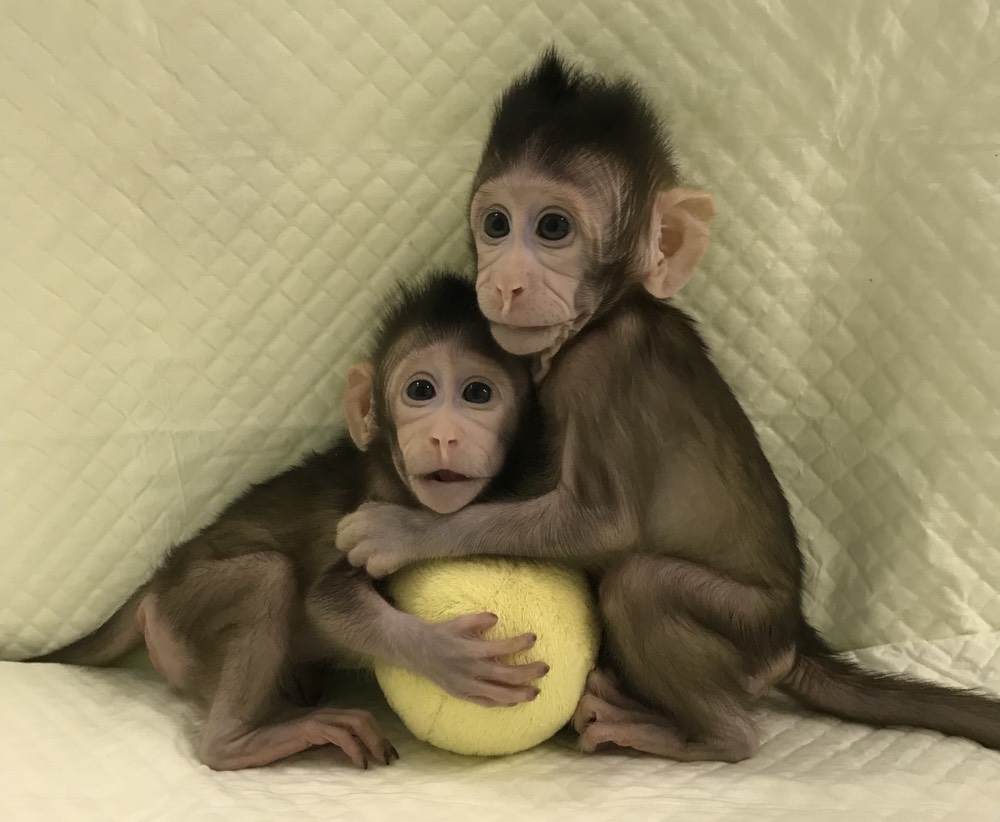Monkeys Have Been Cloned, Paving the Way for Human Cloning

Scientists in China have cloned two bouncing baby monkeys, theoretically opening the door for the cloning of humans.
However, the researchers stressed that they have no intention of cloning humans.
"I would think that the society and general public and the government will not allow the extension of application of these methods from non-human primates to humans," said Mu-ming Poo, director of the Institute of Neuroscience at the Chinese Academy of Sciences. Instead, the goal is to create cloned monkeys that can be used to study human genetic diseases, said Poo, who co-authored a new study describing the results. [8 Mammals That Have Been Cloned Since Dolly the Sheep]
Dolly's legacy
The monkeys, both female, are named Zhong Zhong and Hua Hua from the word "Zhonghua," meaning "Chinese nation." The monkeys are currently about 7 weeks old; they live in the same kind of incubators used for human babies and are bottle-fed by human caregivers. They are very active and seem to be developing like any normal monkey, Poo said during a news conference this week.
The two big-eyed primates were created in a process called somatic cell nuclear transfer. In this method, researchers take an egg cell, or oocyte, and remove its nucleus (which holds its DNA). Then, they take a body, or somatic, cell from the individual they'd like to clone and remove its nucleus, transferring that nucleus into the empty egg. The cell is then allowed to divide and grow for several days to reach a multicell blastocyst stage. The blastocyst is then implanted in the uterus of a surrogate mother monkey to develop into a fetus and, hopefully, a baby.
Dolly the sheep, born in 1996, was the first animal successfully cloned using this technique; specifically, she was cloned from the udder cell of an adult sheep. Dolly died in 2003 at the age of 6. Since her birth, scientists have used somatic cell nuclear transfer to clone more sheep, as well as cows, mice, rats and dogs, but no one has ever been able to clone a nonhuman primate, Poo said.
"Maybe the differentiated somatic nuclei of the primate species are unable to express the genes that are required for embryo development," he said.
Sign up for the Live Science daily newsletter now
Get the world’s most fascinating discoveries delivered straight to your inbox.
Optimized process
To overcome that problem, the researchers refined their technique. They optimized the nuclear transfer with cutting-edge imaging and improved the fusion of the donor cell to the egg cell during the transfer process.

"This is a very difficult and delicate procedure," Poo said; it took many years to practice these techniques.
Even so, the reconstructed embryos failed to develop properly. The breakthrough, the researchers said, was in reprogramming the donor nuclei. They used epigenetics to do this reprogramming, meaning they altered not the DNA sequence itself but the way that individual genes were expressed. In this way, they were able to reactivate the genes required for embryonic development. The technology required to do this epigenetic modulation was developed in the past few years, said Zhen Liu, a study co-author and postdoctoral researcher at the Institute of Neuroscience. [6 Extinct Animals That Could Be Brought Back to Life]
Using connective tissue cells called fibroblasts from the fetuses of long-tailed macaques (Macaca fascicularis) as donors, the researchers created 79 cloned oocytes, which were implanted into 21 surrogate mothers. Six pregnancies took hold, and two developed to full term, the researchers reported today (Jan. 24) in the journal Cell.
The researchers also tried cloning cells from adult monkeys, with less success. Out of 22 pregnancies in 42 surrogates, there were two live births, but both babies died soon after birth. The reason, Poo said, is likely that adult cells are harder to reprogram than more flexible fetal cells. However, the team is working on the technique and currently has female surrogates pregnant with fetuses cloned from adult body cells.
"They seem to be developing well, so we are hoping we will produce babies soon," he said.
Besides being easier to reprogram for early-stage development, fetal cells have other advantages, Poo said: Fetal fibroblasts are easy to grow in the laboratory, and they are also easy to edit genetically. The goal, he said, is to introduce genetic mutations of the same sort that cause human diseases such as Parkinson's.
"Then, the clones will be [an] ideal model for that particular disease, for screening drugs that will cure the disease," Poo said.
The researchers hope to produce gene-edited macaque clones for use in this kind of research within a year.
Original article on Live Science.

Stephanie Pappas is a contributing writer for Live Science, covering topics ranging from geoscience to archaeology to the human brain and behavior. She was previously a senior writer for Live Science but is now a freelancer based in Denver, Colorado, and regularly contributes to Scientific American and The Monitor, the monthly magazine of the American Psychological Association. Stephanie received a bachelor's degree in psychology from the University of South Carolina and a graduate certificate in science communication from the University of California, Santa Cruz.









